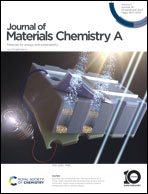Engineering stable construction of MnCo2O4 yolk-in-double-shell amalgamated with bio-synthesized ZnMn2O4 nanoparticles for superior artificial CO2 reduction†
Abstract
Multi-shelled configurations of mixed bimetallic oxides, which are well-known candidates for CO2 photoreduction, were prepared via the calcination of rigid spheres of the self-template glycerate-assisted metal–organic structure. However, the fabrication of highly efficient, stable constructions is still a significant challenge. The effectiveness of this strategy is restricted by the questionable stability of the structure, which collapses under harsh calcination conditions. Herein, we focused our attention on manipulating the initial solvothermal reaction, through which MnCo2O4 yolk-in-double-shell hollow spheres (YDSHS-MCO) were engineered via the formation of two sequential yolk-shells, i.e., one during the solvothermal process and the other during the calcination process. To better understand the origin of the superior performance of this structure, its conventional nanoparticle counterpart (NP-MCO) was synthesized, showing that YDSHS-MCO had a much higher photo/electrochemical merits and CO2-to-syngas conversion, which was 8-fold than that of NP-MCO. In addition, optimized ZnMn2O4 nanoparticles (6-ZMO) prepared via the green sol–gel phyto-mediated method were intimately amalgamated on the nanosheet-assembled exterior YDSHS-MCO shell, resulting in the formation of an astounding S-scheme heterojunction ((80)YDSHS-MCO@6-ZMO). The fusion of the small-sized 6-ZMO nanoparticles with the advantages of crystalline-amorphous structure and quantum-confinement-promoted reduction capability introduced efficient reduction centers on the flower-like exterior YDSHS-MCO shell. As anticipated, in the CO2 photoreduction reaction, (80)YDSHS-MCO@6-ZMO demonstrated a superior performance in realizing syngas production of 1401 μmol g−1 h−1 with the CO selectivity of 87.5% in the liquid–solid phase and 2125 μmol cm−2 h−1 in the gas–solid phase without the applying any photosensitizer/sacrificial agents. Regarding its stability, after a long-term experiment and time-equivalent successive cycling reactions in both systems (gas–/liquid–solid phase), its post-characterization and photocatalytic performance demonstrated the successful resilience engineering. The unique architecture of the stable multi-shell amalgamated with the rational configuration of an S-scheme encompasses a facile, low-cost structure that surpasses its counterparts in various domains.



 Please wait while we load your content...
Please wait while we load your content...